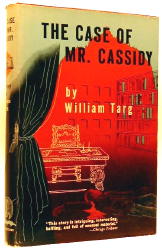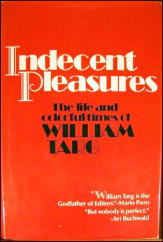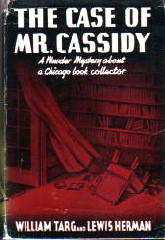Thu 23 Jul 2009
Reviewed by Walter Albert: WILLIAM TARG & LEWIS HERMAN – The Case of Mr. Cassidy.
Posted by Steve under ReviewsNo Comments

WILLIAM TARG – The Case of Mr. Cassidy.
World Publishing Company, hardcover reprint, 1944. Originally published by Phoenix Press, hc, 1939, as by William Targ & Lewis Herman.
This entertaining mystery, set in Chicago (the hometown of William Targ), introduces the erudite, paunchy amateur sleuth, Hugh Morris, who negotiates the pre-WWII Chicago literary scene as he keeps one step ahead of the police in their attempt to discover who murdered wealthy bibliophile James Cassidy and, subsequently, his private secretary.
The police are convinced that the murderer was the mysterious Fiend, who has previously only murdered attractive young women in open areas.
When the police corner and capture the Fiend, opportunely discovered with the body of his latest female victim, he readily confesses to the murder of Cassidy and his secretary, but, convinced that the Fiend is not the murderer of the two men, Morris continues his investigation.

It leads him to Chicago nightclubs, bookstores, and restaurants, familiar landmarks that bring him with such personalities of the period as collector and author Vincent Starrett and bookstore owner Ben Abramson.
Targ’s characters in his novel are skillfully if sketchily portrayed, with the exception of Morris, who comes off as a novelistic alter ego for Targ, sharing the same passionate interest in food, books, and the Chicago scene that characterize Targ as he describes himself in Indecent Pleasures (Macmillan, 1975), his compulsively readable biography.
In addition to the obvious pleasure a book collector will take in the bibliophile aspects that include the important clue of a first edition of Poe’s Tamerlane, the fan of period prose will find some choice linguistic prose rhapsodies, like the following:
Now, with the memory of them still lingering in his mind’s stomach, he had gone into the hamburger shack for his evening meal. The unpredictable irrationality of the human animal, he thought, was what made it a fit subject for Shakespeare’s plays, T. S. Eliot’s poems and Mozart’s music. Man is a hamburger sandwich, he mused, an olla podrida of everything and of nothing, of God-knows-what.

The counter-man is God. He fashions and molds the blob of meat in his hands. The flavor is enhanced by the onions of the earth from which man sprang and the mustard of experience with which he is being constantly smeared. The pickle is the spice of life. The result, like a hamburger sandwich, is always a question mark–the perfect peristalsis of success or the bellyache of failure.
Morris picked his teeth as he thought of the gastronomic theme he had developed, and decided it was definitely beneath his standard of philosophic improvisation. He belched and left the place.
Rex Stout, eat your heart out!
N.b. The Tower reprint (from which I was working) dropped the Herman by-line, but a query to Al Hubin confirmed that the Phoenix first edition did list both Targ and Herman as co-authors. (See also the cover above.)